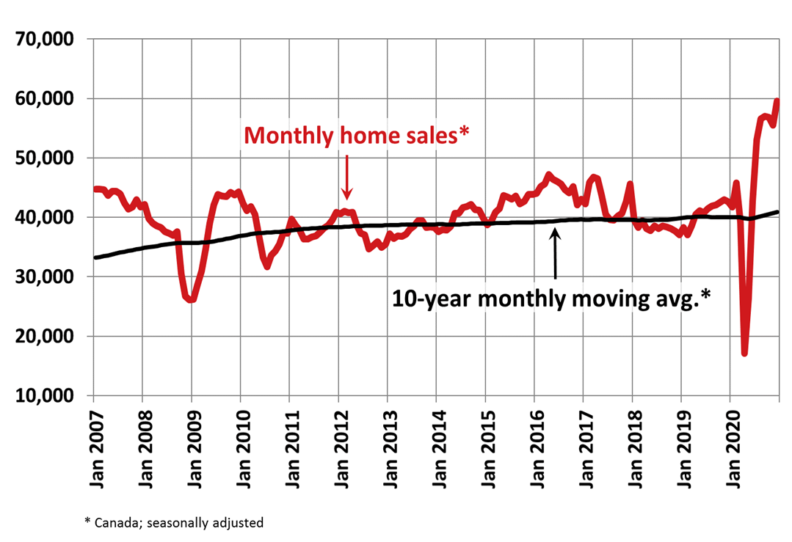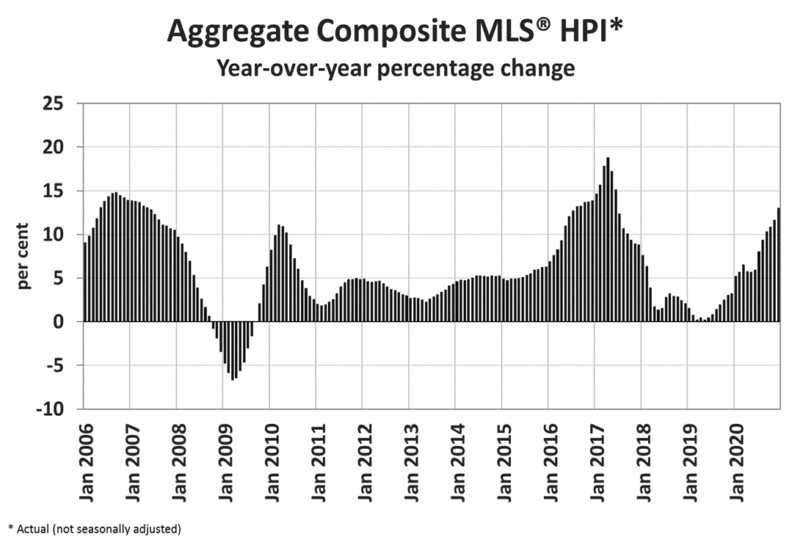Canadian home sales remain historically strong in November
Ottawa, ON, December 15, 2020 – Statistics released today by the Canadian Real Estate Association (CREA) show national home sales continued running at historically strong levels in November 2020.
Summary:
- National home sales edged back 1.6% on a month-over-month (m-o-m) basis in November.
- Actual (not seasonally adjusted) activity was up 32.1% year-over-year (y-o-y).
- The number of newly listed properties also fell back by 1.6% from October to November.
- The MLS® Home Price Index (HPI) rose 1.2% m-o-m and was up 11.6% y-o-y.
- The actual (not seasonally adjusted) national average sale price posted a 13.8% y-o-y gain in November.

Home sales recorded over Canadian MLS® Systems edged back by 1.6% between October and November. Small declines in October and November notwithstanding, monthly activity is still running well above most of history.
The decline from October to November reflected fewer transactions in about 60% of all local markets, notably in large markets – Toronto, Vancouver, Montreal and Ottawa.
Actual (not seasonally adjusted) sales activity posted a 32.1% y-o-y gain in November – the same as in October. It was a new record for that month by a margin of well over 11,000 transactions. For the fifth straight month, year-over-year sales activity was up in almost all Canadian housing markets compared to the same month in 2019. Among the few markets that were down on a year-over-year basis, it is likely the handful from in Ontario reflect a supply issue rather than a demand issue.
So far this year, some 511,449 homes have traded hands over Canadian MLS® Systems, up 10.5% from the first 11 months of 2019. It was the second-highest January to November sales figure on record, trailing 2016 by only 0.3% at this point.
"Many Canadian housing markets continue to see historically strong levels of activity, so much so that a new annual sales record this year is looking more likely every day,” stated Costa Poulopoulos, Chair of CREA. "At the same time, with COVID cases on the rise in a number of provinces, we will remain extremely vigilant, as we have all along, in adhering to government and health officials’ directives and leveraging all the virtual technology available to keep our clients safe. Now more than ever, REALTORS® remain the best source for information and guidance when negotiating the sale or purchase of a home,” continued Poulopoulos.
“If I had to sum up the Canadian housing story in 2020, I would say it’s gone from weakness because of COVID to strength despite COVID,” said Shaun Cathcart, CREA’s Senior Economist. “It will be a photo finish, but it’s looking like 2020 will be a record year for home sales in Canada despite historically low supply. We’re almost in 2021, and market conditions nationally are the tightest they have ever been and sales activity continues to set records. Much like this virus, I don’t see it all turning into a pumpkin on New Year’s Eve, but at least vaccination is a light at the end of the tunnel. Immigration and population growth will ramp back up, mortgage rates are expected to continue to remain very low, and a place to call home is more important than ever. On top of that, the COVID-related shake-up to so much of daily life will likely continue to result in more people choosing to pull up stakes and move around. If anything, our forecast for another annual sales record in 2021 may be on the low side.”
The number of newly listed homes declined by 1.6% in November, led by fewer new listings in the Greater Toronto Area (GTA) and Ottawa.
With sales and new supply down by the same percentages in November, the national sales-to-new listings ratio was unchanged at 74.8% -- still among the highest levels on record for the measure. The long-term average for the national sales-to-new listings ratio is 54.2%.
Based on a comparison of sales-to-new listings ratio with long-term averages, only about 30% of all local markets were in balanced market territory in November, measured as being within one standard deviation of their long-term average. The other 70% of markets were above long-term norms, in many cases well above.
The number of months of inventory is another important measure of the balance between sales and the supply of listings. It represents how long it would take to liquidate current inventories at the current rate of sales activity.
There were just 2.4 months of inventory on a national basis at the end of November 2020 – the lowest reading on record for this measure. At the local market level, some 21 Ontario markets were under one month of inventory at the end of November.
The Aggregate Composite MLS® Home Price Index (MLS® HPI) rose by 1.2% m-o-m in November 2020. Of the 40 markets now tracked by the index, all but one were up between October and November.
As of this release, Chilliwack B.C. is the newest market in the MLS® HPI.

The non-seasonally adjusted Aggregate Composite MLS® HPI was up 11.6% on a y-o-y basis in November – the biggest gain since July 2017. (Chart B)
The largest y-o-y gains – between 25- 30% – were recorded in Quinte & District, Tillsonburg District, Woodstock-Ingersoll and a number of Ontario cottage country areas.
Y-o-y price increases in the 20-25% range were seen in Barrie, Bancroft and Area, Brantford, Huron Perth, London & St. Thomas, North Bay, Simcoe & District, Southern Georgian Bay and Ottawa.
This was followed by y-o-y price gains in the range of 15-20% in Hamilton, Niagara, Guelph, Cambridge, Grey-Bruce Owen Sound, Kitchener-Waterloo, Northumberland Hills, Peterborough and the Kawarthas, Montreal and Greater Moncton.
Prices were up in the 10-15% range compared to last November in the GTA, Oakville-Milton and Mississauga.
Meanwhile, y-o-y price gains were in the 5-10% range in Greater Vancouver, the Fraser Valley, Chilliwack, Victoria and elsewhere on Vancouver Island, the Okanagan Valley, Regina, Saskatoon, Winnipeg, Quebec City and St. John’s NL. Price gains also climbed to around 1-2% y-o-y in Calgary and Edmonton.
The MLS® HPI provides the best way to gauge price trends because averages are strongly distorted by changes in the mix of sales activity from one month to the next.
The actual (not seasonally adjusted) national average home price was just over $603,000 in November 2020, up 13.8% from the same month last year.
The national average price is heavily influenced by sales in Greater Vancouver and the GTA, two of Canada’s most active and expensive housing markets. Excluding these two markets from calculations cuts almost $122,000 from the national average price.
- 30 -
PLEASE NOTE: The information contained in this news release combines both major market and national sales information from MLS® Systems from the previous month.
CREA cautions that average price information can be useful in establishing trends over time, but does not indicate actual prices in centres comprised of widely divergent neighbourhoods or account for price differential between geographic areas. Statistical information contained in this report includes all housing types.
MLS® Systems are co-operative marketing systems used only by Canada’s real estate Boards to ensure maximum exposure of properties listed for sale.
The Canadian Real Estate Association (CREA) is one of Canada’s largest single-industry associations, representing more than 130,000 REALTORS® working through 90 real estate boards and associations.
Further information can be found at http://crea.ca/statistics.
For more information, please contact:
Pierre Leduc, Media Relations
The Canadian Real Estate Association
Tel: 613-237-7111 or 613-884-1460
E-mail: pleduc@crea.ca